Results 6,051 to 6,060 of 12096
Thread: Anandtech News
-
06-07-16, 09:27 AM #6051
Anandtech: AMD Releases Radeon Software Crimson Edition 16.6.1
Here we are with AMD's next driver update, Radeon Sofware Crimson Edition 16.6.1. This brings the driver version to 16.20.1025. With the changes that come along with the update we will see the usual fixes, game support, and a crossfire profile.
New to this release include bug fixes for display flickering while playing videos in a web browser, Crossfire not taking effect in Origin and Uplay applications, and texture flickering issues with Crossfire on Fallout 4. Meanwhile for Radeon Settings, AMD has fixed an issue where the application might fail to open after performing a Windows update and installing the latest Radeon Software Crimson Edition.
With the fixes behind us, we can move to official game support. With this update we are getting support for the recently released Mirrors Edge Catalyst and the upcoming Paragon by Epic Games. There is also a Crossfire profile for Dark Souls III tucked in to the bundle as well.
As always, those interested in reading more or installing the updated hotfix drivers for AMD’s desktop, mobile, and integrated GPUs can find them either under the driver update section in Radeon Settings or on AMDs Radeon Software Crimson Edition download page.
More...
-
06-08-16, 12:19 AM #6052
Anandtech: NVIDIA Releases 368.39 WHQL Game Ready Driver, Adds GTX 1070 Support
As the GeForce GTX 1070 approaches, NVIDIA has prepared a driver release for the upcoming card. Along with support to the coming GPU and a list of fixes, we are receiving game ready support for the brand new games Mirrors Edge Catalyst and Edge of Nowhere.
On the bugfix side of matters, NVIDIA has fixed a stuttering issue with Total War: Warhammer, though NVIDIA notes that Total War: Warhammer is still waiting for an SLI profile and that the game can still show corruption when playing with V-Sync enabled. Alongside Total War, a stuttering issue has been fixed for YouTube while watching in full-screen with Microsoft Edge, and Tom Clancy's the Division would stutter after 20-30 minutes of game play in SLI.
For the remaining fixed issues we have the GeForce GTX 1080 Founders edition spinning its fan up and down rapidly, Metal Gear Solid V: The Phantom Pain was launching to a white screen, and X-Legend Entertainment was reporting that Laplace failed to launch.
Finally, the game ready support NVIDIA has prepared for this round includes support for Mirror's Edge Catalyst by EA Dice and Edge of Nowhere, a VR Lovecraftian horror from Insomniac Games, both of which are seeing release this week. NVIDIA was eager to note how to get an optimal gaming experience with Mirror's Edge Catalyst in their report. Stating that a GTX 970 on High at 1080p, and a GTX 980 Ti on Ultra or a GTX 1080 on Hyper at 1440p will get a 60FPS average. NVIDIA also notes that they have identified a Mirror's Edge Catalyst DirectX crash issue in Windows 8.1 when SLI is enabled. They are working to rectify the issue for a future update.
Anyone interested can download the updated drivers through GeForce Experience or on the NVIDIA driver download page. More information on this update and further issues can be found in the 368.39 release notes.
More...
-
06-08-16, 07:58 AM #6053
Anandtech: ASRock DeskMini 110 mini-STX PC Review
Intel introduced the 5x5 mini-STX form factor late last year with the aim of creating a small form-factor PC between that of a NUC and a mini-ITX build. Compared to the NUC-type machines, the mini-STX allow the end-user to choose a CPU appropriate for the budget and requirements. We have already looked at mini-STX offerings from ECS and MSI before, but, their computing power was restricted by the use of low-power T-series (35W TDP) CPUs. ASRock's first mini-STX machine, the DeskMini, is the first unit to have full support for 65W CPUs along with a stock Intel cooler. The DeskMini is quite affordable - $130 gives the end user a chassis, H110 motherboard and a power adapter. This review analyzes the DeskMini platform, its performance and value proposition.
More...
-
06-09-16, 11:23 PM #6054
Anandtech: Motorola Announces The Moto Z And Moto Z Force
Today at Lenovo’s Tech World event, Lenovo and Motorola announced a plethora of new products, including two new smartphones, the Moto Z and Moto Z Force, which replace the Moto X Play and Moto X Style/Pure Edition at the upper end of its lineup. As the change in letter designation suggests, these new phones differ significantly from Motorola’s previous offerings in both design and function, in addition to the usual hardware upgrades.
Both Z models share much of the same hardware. They both use Qualcomm’s Snapdragon 820 SoC, with four custom Kryo CPU cores running at up to 2.15GHz and an Adreno 530 GPU, paired with 4GB of LPDDR4 RAM—the same formula most current generation flagship phones are using. Both models offer two storage options based on UFS 2.0 NAND, 32GB and 64GB, and support storage expansion with a microSD card.
The Moto X family uses IPS LCD panels, but the Moto Z family switches to AMOLED. At 5.5-inches, they’re also slightly smaller than the Moto X’s 5.7-inch display but retain the same QHD (2560x1440) resolution, giving the new panels a pixel density of 535ppi. Motorola has not said if the new displays support a wide color gamut like most AMOLED displays or if there’s a proper sRGB mode. Motorola has been delivering some nice looking screens the past couple generations—the Moto X Pure Edition’s panel is particularly well calibrated—so hopefully this attention to detail is applied to the Moto Z.Motorola Moto Z Family Moto Z Moto Z Force SoC Qualcomm Snapdragon 820
(MSM8996)
2x Kryo @ 2.15GHz
2x Kryo @ 1.59GHz
Adreno 530Qualcomm Snapdragon 820
(MSM8996)
2x Kryo @ 2.15GHz
2x Kryo @ 1.59GHz
Adreno 530RAM 4GB LPDDR4 4GB LPDDR4 NAND 32GB / 64GB (UFS 2.0)
+ microSD32GB / 64GB (UFS 2.0)
+ microSDDisplay 5.5-inch 2560x1440 AMOLED
Corning Gorilla Glass5.5-inch 2560x1440 AMOLED
Moto ShatterShieldDimensions 153.3 x 75.3 x 5.19 mm
136 grams155.9 x 75.8 x 6.99 mm
163 gramsModem Qualcomm X12 (Integrated)
2G / 3G / 4G LTE (Category 12/13)Qualcomm X12 (Integrated)
2G / 3G / 4G LTE (Category 12/13)SIM Size NanoSIM NanoSIM Front Camera 5MP, 1.4µm pixels, f/2.2, LED flash 5MP, 1.4µm pixels, f/2.2, LED flash Rear Camera 13MP, 1.12µm pixels, f/1.8, Laser AF, OIS, Auto HDR, dual-color LED flash 21MP, 1.12µm pixels, f/1.8, PDAF + Laser AF, OIS, Auto HDR, dual-color LED flash Battery 2600 mAh
non-removable3500 mAh
non-removableConnectivity 802.11a/b/g/n/ac 2x2 MIMO, BT 4.1 LE, NFC, GPS/GNSS, USB Type-C, Moto Mods connector 802.11a/b/g/n/ac 2x2 MIMO, BT 4.1 LE, NFC, GPS/GNSS, USB Type-C, Moto Mods connector Launch OS Android 6.0.1 Android 6.0.1
Both Z models include a touch-based fingerprint scanner on the front and Motorola’s latest TurboPower fast-charging technology that supposedly provides up to 8 or 15 hours of battery life in just 15 minutes for the Moto Z and Moto Z Force, respectively. While neither phone is water and dust proof like Samsung’s IP68 rated Galaxy S7, they do include a water-repellant nano coating that helps protect them from accidental spills or light rain.
Like the Moto X Pure Edition, the Moto Z models have 5MP front-facing cameras with a dedicated flash. Around back, the Moto Z uses a 13MP sensor with laser assisted autofocus paired with an f/1.8 lens and optical image stabilization (OIS) to help improve low-light performance. The Moto Z Force also includes an f/1.8 lens and OIS, but increases resolution to 21MP and upgrades to a hybrid autofocus system that combines phase detect autofocus (PDAF), laser AF, and traditional contrast-based AF as a fallback to improve focus speed and accuracy. The Moto X Pure Edition also has a 21MP rear camera with PDAF, but it appears the Moto Z Force is not using the same Sony IMX230 Exmor RS sensor. Instead, Motorola is using a new sensor that adds Deep Trench Isolation (DTI) technology to improve color fidelity.
Motorola uses a similar design language and materials for both Moto Z models, fusing an all-aluminum chassis with edge-to-edge cover glass on the front. The antennas appear to be located behind plastic inserts on the top and bottom of the back panel, but we will not know for sure until we’ve had a chance to see the phones in person.
While Corning’s Gorilla Glass protects the Moto Z’s screen, the Moto Z Force uses second generation Moto ShatterShield technology to further protect the screen from cracking or shattering if dropped. A five-layer system, Moto ShatterShield uses an aluminum panel below the AMOLED screen to keep it from flexing. A dual touch layer provides redundancy in case one of the touch layers is damaged. Finally, two separate lenses, one of which is likely polycarbonate, provide resistance to cracking and scratching, which is backed by a four-year warranty.
The phone’s earpiece doubles as a mono front-facing speaker, which leaves only the USB Type-C port on the bottom edge. If you look closely, you’ll notice that there’s no 3.5mm headphone jack; the Moto Z uses the Type-C port for audio. This will surely be a divisive decision, but Motorola is at least including a 3.5mm to Type-C port headphone adapter. Of course, using the adapter means you cannot listen with headphones and charge the phone at the same time.
The relatively large lower bezel is also a concern, because it may further limit the ability to reach the upper portion of the screen and to comfortably use the onscreen keyboard. Motorola’s decision to use a square fingerprint sensor is partly to blame, but it also looks like the display’s control circuitry is sitting behind the “moto” logo below the screen. This less than advantageous placement is probably the result of the Moto Z’s razor-thin chassis.
The Moto Z is only 5.19mm thick, while the Moto Z Force is just under 7mm thick. There’s a reason why Motorola opted for such a thin design, which I’ll discuss in a minute, but first we need to consider the other side effects of the Z’s slim chassis. The most obvious is how far the rear camera module protrudes from the back. The more serious issue, however, is the impact on battery capacity. Motorola was able to squeeze a 3500 mAh battery into the Moto Z Force’s thicker body, but at 2600 mAh, the Moto Z has a relatively small battery for a phone with a 5.5-inch display and high-end SoC, leading to concerns about battery life.
So why did Motorola push for such thin designs? Because of its modular accessories it calls Moto Mods that snap into place on the back of the phone using strong magnets. These accessories all add additional thickness to the phone, so eliminating unnecessary bulk was a priority. Initially, there will be a range of real wood, leather, and fabric patterned decorative backplates that sit flush with the rear camera when snapped into place. There’s also the JBL SoundBoost speaker that adds two 27mm diameter, 3W speakers; a built-in kickstand for propping up the phone; and an additional 1000 mAh battery, along with the Moto Insta-Share Projector, which outputs a 854x480 WVGA image at 50 lumens nominal using DLP technology. Incipio’s Offgrid Power Pack adds a 2220 mAh battery and the option to add wireless charging support.
Motorola says the Moto Mods are automatically recognized when snapped on and only require a one-time setup process. Unlike with LG’s modular G5, the Moto Z does not need to be rebooted when swapping modules, which is a definite plus. Also, Motorola says that Moto Mods will be compatible with future generation phones, although how far this will extend is unknown.
In the U.S., both phones will initially be Verizon exclusives under the DROID brand. The Moto Z DROID Edition and the Moto Z Force DROID Edition will be available this summer along with the Moto Mods announced today. The Moto Z will be available unlocked this fall from moto.com and various retailers. There will also be an international version of the Moto Z available in September. Pricing has not been announced yet.
More...
-
06-10-16, 08:44 AM #6055
Anandtech: Kingston Updates HyperX DDR4 Lineup with DDR4-3000, DDR4-3200 Modules
Following Intel’s announcement of the new Core i7 Broadwell-E lineup of HEDT processors with six, eight and ten cores, Kingston has recently refreshed its HyperX family of DDR4 memory modules. The new kits offer up to 64 GB capacities and run at data rates of up to 3333 MT/s with relatively low timings.
The new Kingston HyperX Predator Black DDR4 memory modules feature 4 GB, 8 GB and 16 GB capacities and are offered in 8 GB, 16 GB, 32 GB and 64 GB dual-channel and quad-channel kits. Being designed primarily for quad-channel memory sub-systems (yet, compatible with all DDR4-supporting PCs), the modules will run at low data rates of 3000MT/s, 3200MT/sand 3333MT/s(dual-channel only for 3333), and timings of CL15 for 3000 MT/s or CL16 for 3200/3333 MT/s. All modules are rated to operate at the recommended DDR4 enthusiast setting of 1.35 volts, which is higher than JEDEC’s recommendations, but is in line with the voltage of all high-end DDR4 memory sticks.
To simplify setting the right clock-rates and timings on compatible Intel X99 and Intel 100-series motherboards, the HyperX Predator Black modules support XMP 2.0 SPD profiles. To maximize their cooling capabilities for overclocking, the memory sticks are equipped with aluminum heat spreaders. All of Kingston’s HyperX Predator Black DDR4 modules are validated to work with Skylake-S (i7-6700K etc), Haswell-E (5960X etc) and Broadwell-E (6950X etc) processors.Kingston HyperX Predator Black DDR4 DIMMs and Kits Data rate Latency Module Capacity Kit Capacity Number of Modules Voltage Part Number 3000 MT/s CL15 4 GB 8 GB 2 1.35V HX430C15PB3K2/8 4 GB 16 GB 4 HX430C15PB3K4/16 8 GB 16 GB 2 HX430C15PB3K2/16 8 GB 32 GB 4 HX430C15PB3K4/32 16 GB 32 GB 2 HX430C15PB3K2/32 16 GB 64 GB 4 HX430C15PB3K4/64 3200 MT/sCL16 4 GB 8 GB 2 1.35V HX432C16PB3K2/8 4 GB 16 GB 4 HX432C16PB3K4/16 8 GB 16 GB 2 HX432C16PB3K2/16 8 GB 32 GB 4 HX432C16PB3K4/32 3333 MT/sCL16 8 GB 16 GB 2 1.35V HX433C16PB3K2/16
Exact prices of the new HyperX Predator Black DDR4 memory modules from Kingston are unknown, but we expect them to be in line with similar components of these specifications.
Gallery: Kingston Updates HyperX DDR4 Lineup with Faster Modules for HEDT Systems





More...
-
06-10-16, 08:44 AM #6056
Anandtech: Sirin Labs Solarin Launched: World’s First Commercial Smartphone with WiGi
Sirin Labs, a developer of smartphones from Switzerland, last week announced its Solarin smartphone which promises to combine a luxurious design with high performance components, advanced security and support for technologies that have not reached the mass market yet, such as WiGig. The handset is designed for those who travel a lot, require sophisticated security, want an exclusive look, and can pay hefty sums of money. The price of the Solarin starts from £9500 ($13,688) without tax, but the company has alluded that it can build versions that are much more expensive using rarer materials.
Luxurious smartphones from companies like Vertu or Mobiado, as well as custom-built iPhone and Galaxy S handsets from jewelers, have existed for years are becoming a pretty common sight in high-end boutique fashion stores. While such devices boast with exclusive design and feel, they use mass market platforms and typically lack exclusive functionality (concierge service is not a feature of a device, but a service of the brand). As a result, when it comes to features like security or connectivity, bespoke phones typically offer the same feature set as the standard devices. By contrast, the Solarin from Sirin Labs promises several capable security capabilities as well as WiGig support on a smartphone running Google Android.
Strong Comms and Security
The Sirin Labs Solarin is based on Qualcomm’s Snapdragon 810 application processor and comes with a 5.5” IPS display with 2560×1440 resolution, 120% sRGB color gamut as well as curved Corning Gorilla Glass 4. The device also comes with 128 GB of NAND flash storage as well as 4 GB of LPDDR memory.
Communication capabilities of the Solarin appear to be among its most advertised features because the device has Qualcomm’s X10 LTE modem (up to 450 Mbps downlink and up to 150 Mbps uplink speeds) that supports 24 4G/LTE bands worldwide, 802.11ac 2×2 MU-MIMO Wi-Fi as well as WiGig (802.11ad) technology with support of data-rates up to 1.5 Gbps.Specifications of Sirin Labs Solarin SoC Qualcomm Snapdragon 810 (octa core, 2 GHz) processor
Adreno 430 graphicsRAM 4 GB LPDDR (3/4?) Storage 128 GB Display 5.5"
2560×1440
IPS with PFS LED backlight
1500:1 contrast ratio
600cd/m² max brightnessNetwork 4G LTE: LTE Cat 9 rel. 11 with 450 Mbps DL and 50 Mbps UL
3G: UMTS/HSPA+/TD-SCDMA with 42 Mbps DL and 11 Mbsp UL
2G: GSM/GPRS/EDGE class 12, 850/900/1800/1900 MHzWi-Fi 802.11a/b/g/n/ac Wi?Fi
2x2 MU-MIMO up to 866 MbpsWiGig 60 GHz
1.5 GbpsBluetooth Bluetooth 4.1 with BLE and A2DPNFC USB USB Type-C
5 Gbps transfer rateDimensions 159.8 × 78 × 11.1 (mm) Weight 250 grams Rear Camera 23.8 MP, LED flash Front Camera 8 MP Battery 4040 mAh OS Google Android 5.1.1 Additional - SIM Size Hot-swappable nano SIM
WiGig operates in 60 GHz frequency range and enables transfer rates up to 7 Gbit/s, but its propagation is limited to direct lines of sight because the high-frequency signal cannot penetrate walls, ceilings, floors, etc. Companies like Intel and Qualcomm believe that WiGig could be used for wireless docking stations, video streaming and other applications, which require fast data rates and do not need to communicate through concrete obstacles. Right now, there are not a lot of devices supporting WiGig, even though Intel has been shipping its Intel Wireless 802.11ad modules for client and sink devices for well over a year now. However, when appropriate docking stations hit the market, owners of Solarin smartphones will be ready.
Another major feature of the Solarin is its security. While the smartphone uses Google Android and naturally relies on public wireless networks, it has a special mode which is activated by a special security switch on the back of the handset. In the secure mode, the Solarin can communicate only with other Solarin phones for encrypted calls and messages (Wi-Fi, Bluetooth, etc. are switched off), which implies that it contains a special chip that can handle real-time encryption/decryption of voice data. While we do not know the details, it seems that the Solarin supports technology akin to Blackberry’s Secusmart (which it acquired in 2014), which was used by multiple high-profile officials, including German Chancellor Angela Merkel, for voice communications that were encrypted using a 128-bit key in real-time. Moreover, even when working in normal mode, the phone uses 256-bit AES encryption for some of the chip-to-chip communications as well as monitors and prevents attempts to break into it using built-in security software. While encryption for chip-to-chip communications seems to be something excessive, and potentially performance-limiting, the manufacturer claims that some of the leading-edge military devices support this as well. Naturally, the Solarin also supports features like full disk encryption, remote lock/wipe and so on. To access the phone, a fingerprint will be required.
Since the Solarin comes with multiple software features developed in-house, do not expect frequent upgrades of its feature set. Out-of-the-box, the device uses Android 5.1.1 and it is unclear whether Sirin Labs has plans to offer 6.0 or more advanced operating systems over time.
Design
Unlike Blackberry handsets, the Solarin is designed to not just be secure, but also to act as a luxurious phone, which means that it should be stylish. The chassis of the smartphone is made of a metal matrix composite with titanium panels to make it strong, yet relatively light. The bezels can be coated with gold, titanium or another material. The backside of the phone looks like carbon fiber, but the manufacturer claims that it is actually leather, which should feel a lot better. Overall, the visual aesthetics of the launch devices looks very good.
The powerful hardware and design of the Solarin are accompanies by a 23.8 MP back-facing camera featuring laser autofocus, optical image stabilization and four-tone LED flash (considering the price of the device as well as the leading-edge sensor, a real xenon flash would have been a lot better) as well as an 8 MP front-facing camera for video calls. As expected from an expensive smartphone, the Solarin also boasts with four microphones as well as three speakers with an amplifier. The internal DAC is claimed to belong to the high end of the spectrum to ensure high-quality audio when headphones are used, although exact specifications are unknown at this point.
The Solarin comes equipped with a 4040 mAh battery that supports Qualcomm’s quick charge technology, supporting up to two weeks of standby time and up to 31 hours of talk time, according to the developer. In real life, battery life greatly depends on use model, especially when all the security and encryption features of the Solarin are taken into account. Still with a battery of this capacity, do not expect Solarin to be behind other smartphones with 1440p displays when it comes to battery life.
Initially, Sirin Labs will offer four versions of the Solarin in its boutiques in London as well as the online store with prices starting from £9500 ($13,688) without tax. Eventually, the company could offer new models, or even build to order options.
(Additional by Ian: Something makes me want to go to a local showroom and get some hands-on time.)
Sources: Sirin Labs, Pocket Lint.
Gallery: Sirin Labs Solarin: World’s First Smartphone with WiGig and Ultimate Security





More...
-
06-10-16, 09:57 AM #6057
Anandtech: NZXT H440 EnVyUs Announced: The 'Designed by Razer' Chassis Gets an e-Spor
The original H440 was co-designed between NZXT and Razer a couple of years ago and then sold by NZXT. For Computex, NZXT has announced a new version of its H440 PC chassis - in addition to the original black and green and then pure white designs, the H440 gets a new color scheme, which includes black, white and blue.
The new version of the H440 was a collaboration by NZXT and Team EnVyUs, a professional e-Sports team that NZXT sponsors and thus this new design will feature the e-Sports team branding. The case features team colors, aesthetics. and the logotype of the team on the front panel. The NZXT H440 EnVyUs was designed primarily for gamers, e-Sport fans who respect the team as well as those, who wanted this particular chassis, but with black, white and blue color scheme. Apart from the colors, the new NZXT H440 mid-tower case is identical to its predecessors. It is made of steel and plastic and is compatible with ATX, Micro-ATX and Mini-ITX motherboards.
Inside, the H440 chassis features seven openings for PCI expansion cards, up to eight 2.5” bays for SSDs/HDDs and up to eleven 3.5” bays for storage devices. It also supports two 140 mm or three 120 mm front fans, two 140 mm or three 120 mm top fans as well as one 140mm or 120 mm rear fan. Users can install graphics cards that are up to 428 mm long (if no storage devices are installed on their place) or up to 294 mm long when the case is fully populated with HDDs or SSDs. Like other modern chassis, the NZXT H440 EnVyUs fully supports the installation of liquid cooling. Outside, the H440 has two USB 2.0 ports, two USB 3.0 ports as well as two 3.5 mm mini-jack connectors.NZXT H440 EnVyUs Motherboard Size ATX, Micro-ATX, Mini-ITX Drive Bays External 0 × 5.25" Internal 11 × 3.5" and 8 x 2.5" Cooling Front 2 × 140 mm or 3 × 120 mm (3 × 120 mm included) Rear 1 × 120 mm or 1 × 140 mm (included) Top 2 × 140 mm or 3 × 120 mm HDD/Side - Bottom - Radiator Support Front Unknown Rear Up to 140 mm (?) Top Up to 360 mm Side - Bottom - I/O Port 2 × USB 3.0, 2 × USB 2.0, 1 × Headphone, 1 × Mic Power Supply Size ATX Dimensions W: 220mm × H: 513mm × D: 480mm Features of the NZXT H440 EnVyUs · Glass side panel
· Integrated power supply shroud
· NZXT FNv2 case fans with anti-vibration padsPrice $139.99
The NZXT H440 EnVyUs will be available in the U.S. and Europe in mid-June. The recommended price will be $139.99.
Gallery: NZXT H440 EnVyUs: NZXT’s Designed by Razer Case Gets a Special Edition



More...
-
06-10-16, 09:57 AM #6058
Anandtech: Capsule Review: SteelSeries Apex M500 Gaming Mechanical Keyboard
SteelSeries is a well-known manufacturer of gaming peripherals. Despite that, until recently they offered only a handful of mechanical keyboards, and those were using proprietary switches. Today we are having a look at their latest gaming keyboard, the Apex M500, a no-frills product based on Cherry’s MX Red mechanical switch.
More...
-
06-13-16, 08:30 AM #6059
Anandtech: Razer Exhibits OSVR HDK2 VR Headset, And $5 Million Developer Fund At E3 2
The Open Source Virtual Reality (OSVR) headsets have been progressing in the new field of VR for some time, releasing and demoing several versions of their Hacker Development Kit (HDK) for a while now, and we even saw some demos back at CES 2015. They have been iterating the design a few times, with the current version being HDK 1.4. Today OSVR is announcing the updated HDK 2.
The big improvement to HDK 2 compared to HDK 1.4 is the new display panel. HDK 2 now features the same 2160x1200 resolution OLED display as the Oculus rift, and with the same 90 Hz refresh rate. Resolution is still a big issue with VR kits, and the previous version was just a 1920x1080 display, so this is a nice step up in pixels per inch. VR is still going to need higher resolution, but at the moment the HDK 2 does meet the benchmark laid down by the other players in this space.
In order to help reduce the screen-door effect, the HDK 2 also has what they are labelling IQE, or Image Quality Enhancer, which, according to the OSVR spokesman, is an optical coating to help with this pronounced issue with VR glasses. Likely this means that it is attempting to blur the pixels, in order to have them blend in with the other pixels. The displays do need to improve to remove this completely, and it doesn’t help that the OLED panels are actually pentile. I’d need to test this kit in person to get a good feeling for how well they have done with the coating, but there are of course downsides to blurring the image, even if it does help with one of the biggest issues with VR.
The HDK 2 comes with a 100 Hz IR camera for positional tracking, and the headset features individual eye focusing with the dual-lens system. Adjustments can be made from +4.5 to -2 per eye, which should allow it to work with the majority of users. The headset itself has a removable face mask, with bamboo charcoal microfiber foam. Unlike the Rift, there is no audio integrated with the headset.
OSVR has an open framework (as suggested by its name) so it will be able to work with a variety of controllers, and as more control mechanisms become available, it should be able to support them. The HDK system supports several content technologies, including SteamVR, and they plan to announce more content soon.
On that note, OSVR is also announcing a $5 million developer fund. Their goal is to ensure unrestricted access of VR content on all hardware. If you are a VR content developer, you can apply to this fund. If approved by the fund, and OSVR support is added to the content, Razer, or other future contributors, will purchase game codes in bulk to help compensate developers for their integration time, and the fund will also assist with marketing and promotional support.
The HDK 2 will be available for purchase at the beginning of July, and here OSVR is trying to win over some support by undercutting the competition. The HDK 2 will retail for just $399, compared to $599 for the Oculus Rift and $799 for the HTC Vive. In addition, the HDK 1.4 will remain on sale for $299.
I think OSVR has a long road ahead of them, since they are up against some well-backed competition, but it’s great to see the VR space already showing competition. Strong players should spur innovation in the field and lead to better products for all.
Source: Razer
More...
-
06-13-16, 08:30 AM #6060
Anandtech: Intel Launches 4S and 8S Broadwell-EX Xeons: E7-4800 v4 and E7-8800 v4 Fam
The super-high-end of Intel’s Xeon CPU range, based on servers with as many cores and as much memory as you can throw at them, represent a good part of Intel’s business with the potential to offer large margins: some customers want the most, the best, the powerful, and are willing to pay for it. For a number of generations, this has come via the Intel E7 line, consisting of two families of products designed for quad-socket servers (the E7-4000 v4) and eight socket servers (the E7-8000 v4). The new element to this launch is the use of ‘v4’, meaning that following the launch of Broadwell-EP for 1S/2S systems a couple of months ago and Broadwell-E (high-end desktop, HEDT) two weeks go, Intel has now filled out the v4 product line as we would typically expect. The new Xeons will be under the Broadwell-EX nomenclature (following Haswell-EX, Ivy Bridge-EX and so on), and using the Brickland platform aimed at mission critical environments.
Intel currently runs several processor lines in the Xeon/enterprise space, from E3-1200 v5 processors using consumer level performance in a Xeon package, the recently released E3-1500 v5 processors with embedded DRAM to help accelerate visual/video workflow, all the way up to the large EX core platforms.
As referred to in Johan’s very detailed review of the dual socket E5-2600 v4 platform, Broadwell Xeon processor dies come in three die sizes: a low core count (LCC) featuring ten physical cores at 246.24 mm2 for ~3.2 billion transistors, a medium core count (MCC) with fifteen physical cores at 306.18 mm2 for ~4.7 billion transistors, and high core count (HCC) with 24 physical cores at 456.12mm2 for ~7.2 transistors. The MCC and HCC arrangements use dual memory controllers to address four memory channels whereas the LCC die uses a single memory controller which results in a slight performance hit compared to the other two. Most of the new E7 v4 processors however will be using the HCC die.Intel Xeon Families (June 2016) E3-1200 v5 E3-1500 v5
E3-1500M v5E5-1600 v4
E5-2600 v4E7-4800 v4 E7-8800 v4 Core Family Skylake Skylake Broadwell Broadwell BroadwellCore Count 2 to 4 2 to 4 4 to 22 8 to 16 4 to 24 Integrated Graphics Few, HD 520 Yes, Iris Pro No No No DRAM Channels 2 2 4 4 4 Max DRAM Support (per CPU) 64 GB 64 GB 1536 GB 3072 GB 3072GB DMI/QPI DMI 3.0 DMI 3.0 2600: 1xQPI 3 QPI 3 QPI Multi-Socket Support No No 2600: 1S or 2S 1S, 2S or 4S Up to 8S PCIe Lanes 16 16 40 32 32 Cost $213 to
$612$396 to
$1207$294 to
$4115$1223 to
$3003$4061 to
$7174Suited For Entry Workstations QuickSync,
Memory ComputeHigh-End Workstation Many-Core Server World Domination
Intel has formally announced eleven processors between the 4S and 8S families, varying in core count, frequency, power consumption and L3 cache. The design of the HCC core is such that a processor can have certain cores fused off but the rest of the die can have access to the L3 cache, providing some SKUs with more ‘total cache per core’, such as the E7-8893 v4 which will be a four-core design but with 60 MB of L3 cache between them. These are classified by Intel as 'segment optimized', where applications require faster cache rather than more cores. This is arguably a stone-throw away from an eDRAM SKU with 64MB of eDRAM, but in this case Intel is still going with a large (and faster than eDRAM) L3 cache.
The flagship model is the E7-8890 v4, a 165W processor supporting the full 24 cores in the HCC die with hyperthreading, offering 48 threads per CPU. At a base frequency of 2.2 GHz, this processor can be used in an eight-socket glueless configuration (an 8S implementation means 192 cores/384 threads) or up to 128 sockets using third party controllers. In the eight socket configuration, a system can support up to 24TB of DDR4 LRDIMMs (three modules per channel, 12 modules per socket, 256GB per module). All the CPUs listed will support DDR4 and DDR3 with the dual controller configuration.Intel E7-8800 v4 Xeon Family E7-8860 v4 E7-8867 v4 E7-8870 v4 E7-8880 v4 E7-8890 v4 E7-8891 v4 E7-8893 v4 TDP 140 W 165 W 140 W 150 W 165 W 165 W 140 W Cores 18 / 36 18 / 36 20 / 40 22 / 44 24 / 48 10 / 20 4 / 8 Base (MHz) 2200 2400 2100 2200 2200 2800 3200 Turbo (MHz) 3200 3300 3000 3300 3400 3500 3500 L3 Cache 45 MB 45 MB 50 MB 55 MB 60 MB 60 MB 60 MB QPI (GT/s) 3 x 9.6 3 x 9.6 3 x 9.6 3 x 9.63 x 9.6 3 x 9.6 3 x 9.6 DRAM Support DDR4-1866
DDR3-1600DDR4-1866
DDR3-1600PCIe Support 3.0 x32 3.0 x32 3.0 x32 3.0 x32 3.0 x32 3.0 x32 3.0 x32 Price $4061 $4672 $4762 $5895 $7174 $6841 $6841
The E7-4800 v4 line by comparison will use a reduced QPI speed (6.4 or 8.0 gigatransfers per second compared to 9.6 gigatransfers per second on the E7-8800 v4) as well as some of the family having no Turbo frequencies. These non-turbo processors will run at their given frequency no matter the loading.Intel E7-4800 v4 Xeon Family E7-4809 v4 E7-4820 v4 E7-4830 v4 E7-4850 v4 TDP 115 W 115 W 115 W 115 W Cores 8 / 16 10 / 20 14 / 28 16 / 32 Base (MHz) 2100 2000 2000 2100 Turbo (MHz) - - 2800 2800 L3 Cache 20 MB 25 MB 35 MB 40MB QPI (GT/s) 3 x 6.4 3 x 6.4 3 x 8.0 3 x 8.0 DRAM Support DDR4-1866
DDR3-1600PCIe Support 3.0 x32 3.0 x32 3.0 x32 3.0 x32 Price $1223 $1502 $2170 $3003
The new E7 v4 carries over all of the new features that Johan covered in our E5 v4 review, including:
- VM cache allocation (the ability for a supported hypervisor to mark a VM as high priority or partition cache as needed for QoS),
- New memory bandwidth monitoring tools,
- New frequency/power management tools to reduce frequency adjustment latency (see slide 29),
- Transactional extension support (TSX, was a feature in Haswell but disabled due to a fundamental hardware bug),
- A new non-deterministic random bit generator instruction for seed generation,
- Haswell to Broadwell generational improvements (decreased divider latency, 40% faster vector floating point multiplier, hardware assist for vector gather, cryptography focused instructions),
- AVX Turbo modes affect single cores rather than the whole processor,
- Entry/Exit latency for virtualization environments reduced to ~400 cycles from ~500 cycles.
There are a couple of features for the HCC based processors that may be more relevant for the 4S systems, such as an upgraded version of Cluster on Die. Due to the configuration of the die and the dual ring design, if a core needs data in an L3 cache on the other side of the die, the latency would be higher than if it was closer to the die. To alleviate this, Haswell E5/E7 Xeons separated each die into two clusters such that each part would be seen by the BIOS as a non-unified memory domain. This allows the home agent/system agent to manage the likelihood that memory requests are aimed at data closer to the core that needs it. In Broadwell, this feature is now brought up from dual-processor systems to four-processor systems, and should reduce last level cache latency and performance for larger systems.
The new E7 v4 processors use the same socket as the previous generation, the E7 v3 processors. With a BIOS update, the new processors are a drop in with the older platform. The usual Intel partners (Supermicro, HP Enterprise, Dell, Cray) are expected to offer systems based on the new processors. We expect the new processors to cost in line with the previous generation with a typical generational increase. I believe Johan is currently in the process of testing a few parts, and I’m looking forward to the review.
More...
Thread Information
Users Browsing this Thread
There are currently 62 users browsing this thread. (0 members and 62 guests)




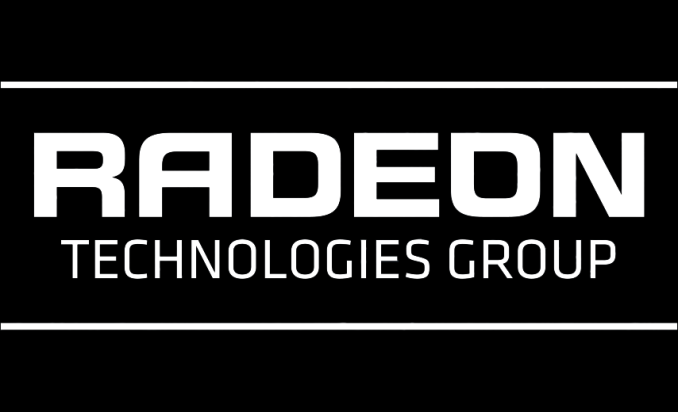

 Quote
Quote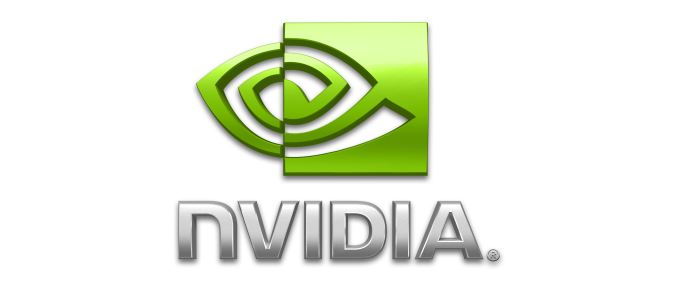
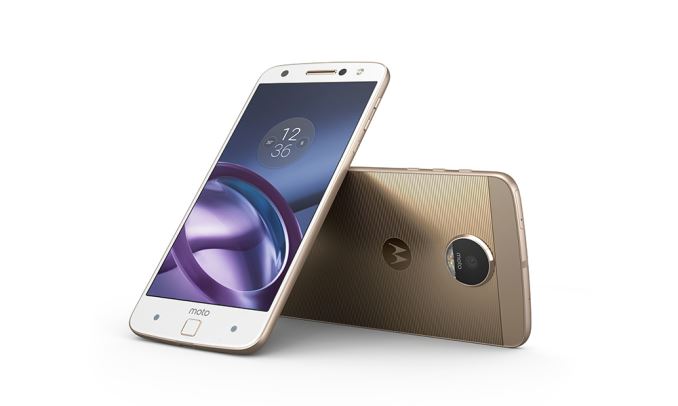
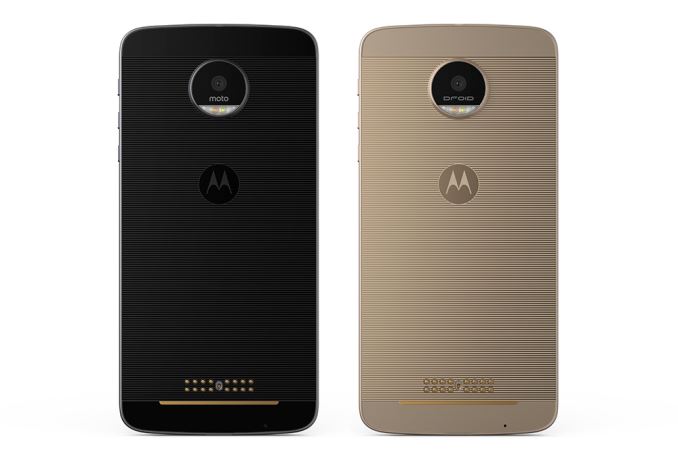
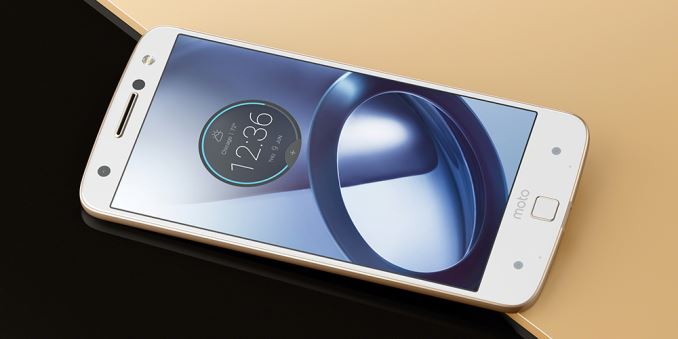
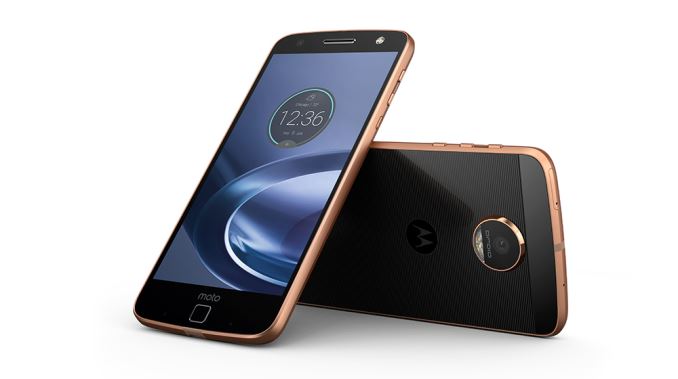
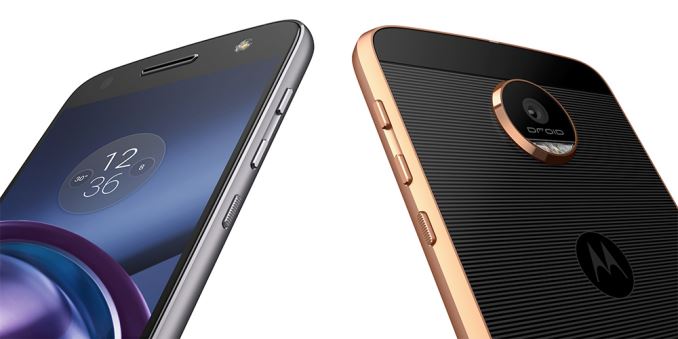
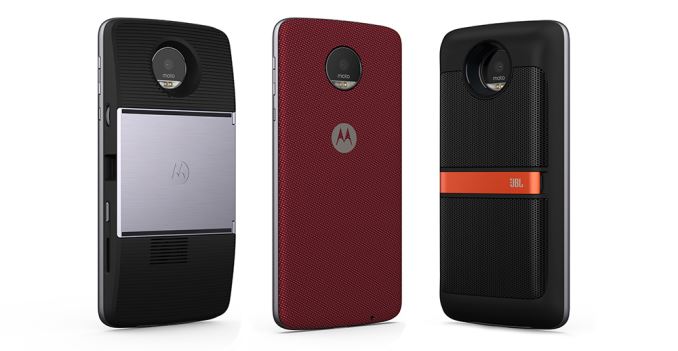
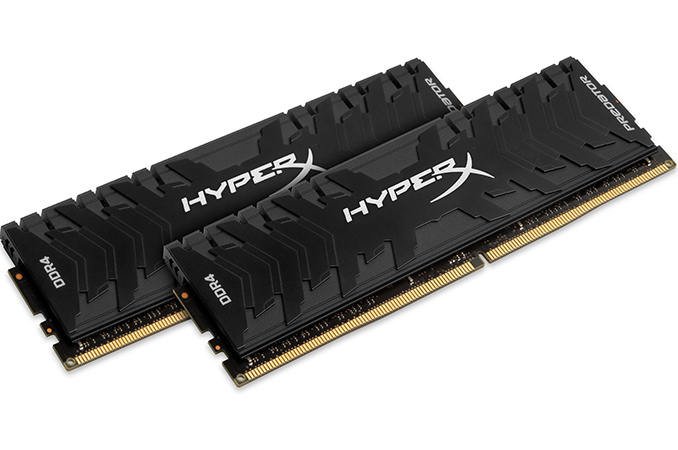

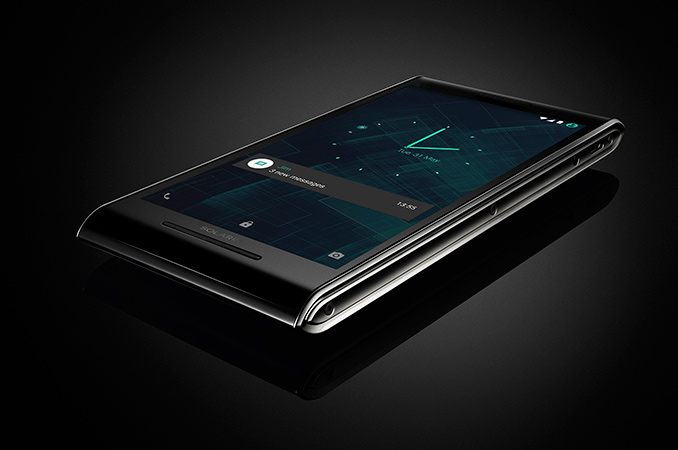
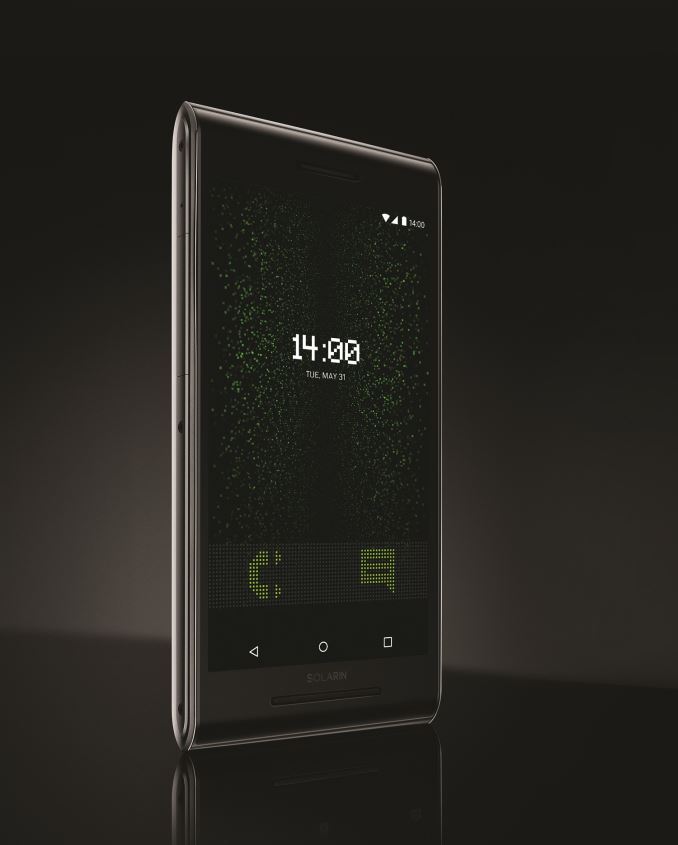
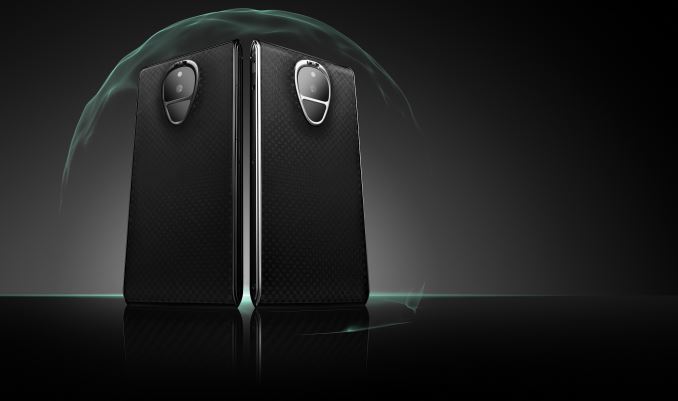
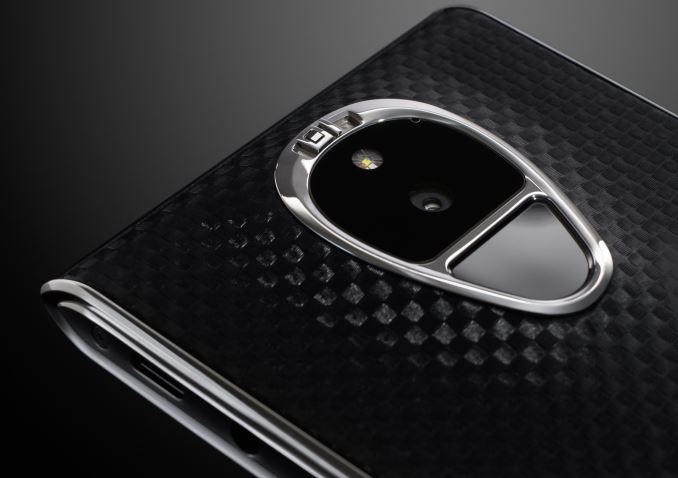
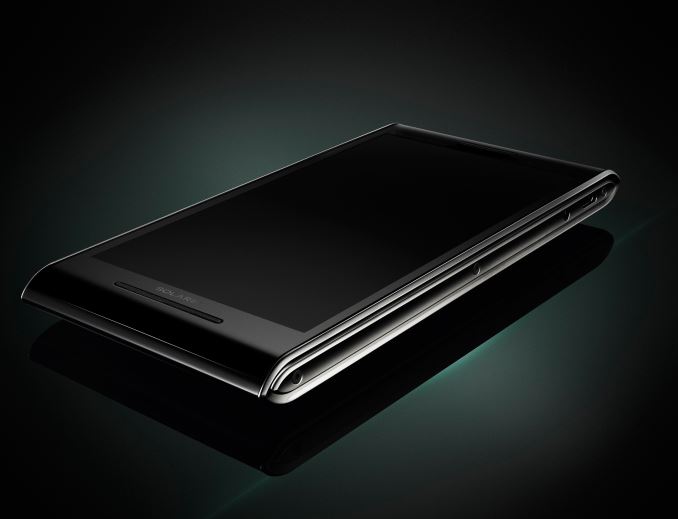
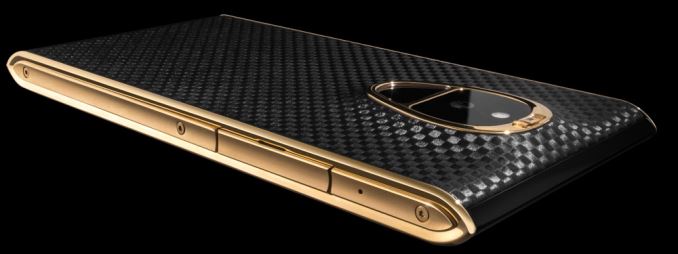
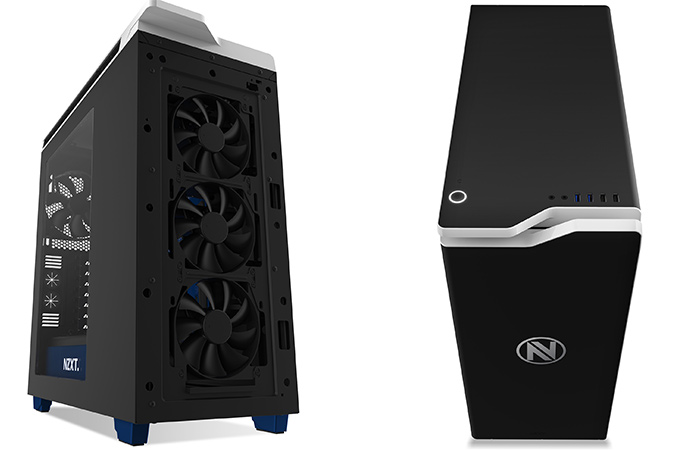


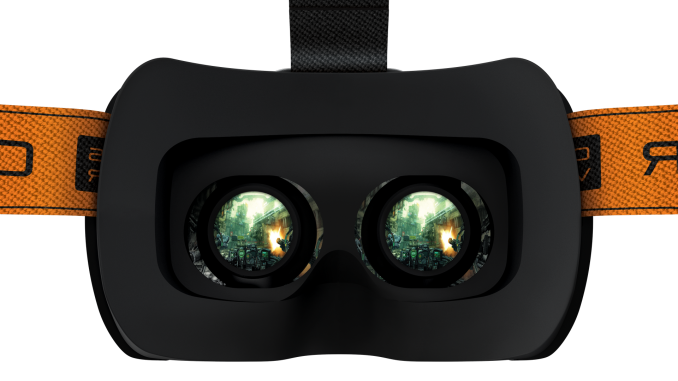


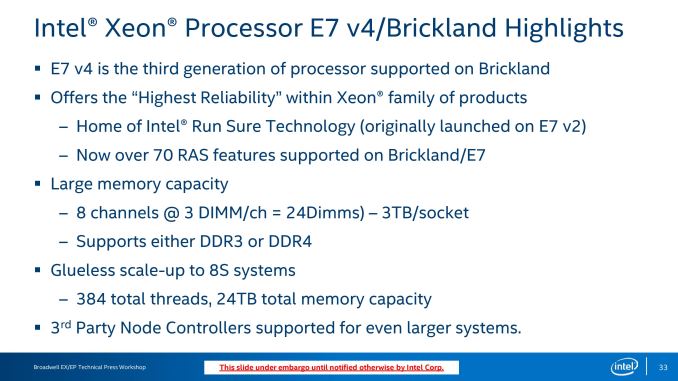
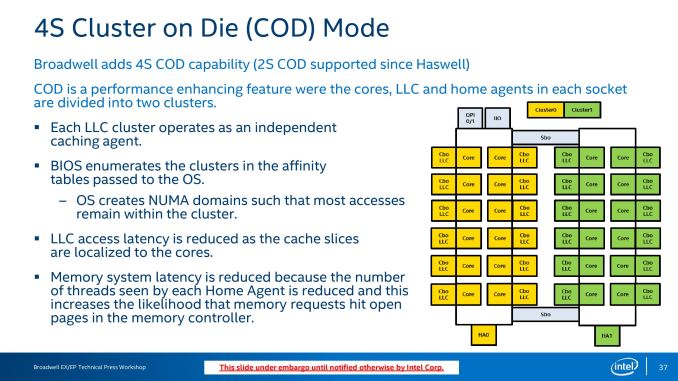
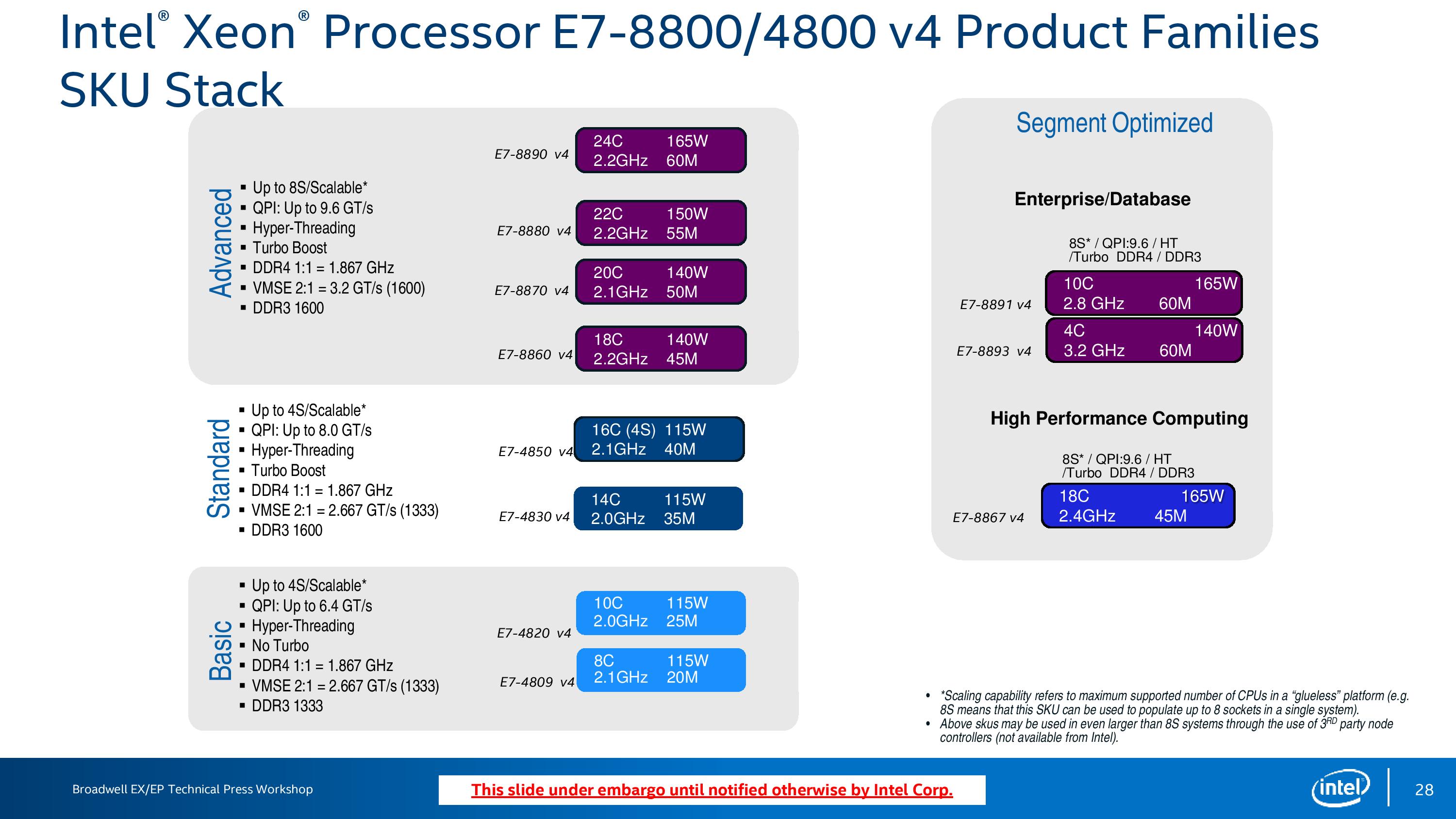
















Bookmarks